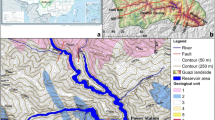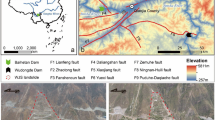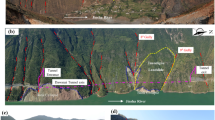Abstract
This paper presents an in-depth analysis of the deformation characteristics and reactivation mechanisms of a giant ancient translational landslide in the Three Gorges Reservoir (TGR) based on more than 6 years of monitoring data with the assistance of in situ surveys. The Outang landslide, divided into three active parts, has a total volume of approximately 90 million m3 and slides along weak interlayers (WIs). Since the impoundment, the landslide has been experiencing persistent deformations with some distinct movement signs. The temporal displacements are marked by seasonal cycles of fast displacements in the summer followed by almost imperceptible movements for the remainder of each hydrologic year. The spatial displacement rates gradually increased with the increase in altitude. The primary triggering factors for slope movement could transition from the drawdown of the reservoir water to the periodic rainfall. The affected areas by the former and latter are mainly concentrated in the front part and the upper part of the slope, respectively. The landslide exhibited a composite push-retrogression-type failure evolution with the fluctuating reservoir levels destabilizing rock masses at the front part of the landslide and the precipitation mainly mobilizing materials in the upper part of the slope. Currently, the landslide is in a state of continuous movement. The toe area and upper part of the landslide should receive high priority for the development of preventative measures.













Similar content being viewed by others
References
Cen DF, Huang D, Song YX, Jiang QH (2020) Direct tensile behavior of limestone and sandstone with bedding planes at different strain rates. Rock Mech Rock Eng
Chen KT, Wu JH (2018) Simulating the failure process of the Xinmo landslide using discontinuous deformation analysis. Eng Geol 239:269–281
Chen ML, Lv PF, Zhang SL, Chen XZ, Zhou JW (2015) Time evolution and spatial accumulation of progressive failure for Xinhua slope in the Dagangshan reservoir, Southwest China. Landslides 15(3):565–580
Crosta GB, Imposimato S, Roddeman D (2015) Landslide spreading, impulse water waves and modelling of the Vajont rockslide. Rock Mech Rock Eng 49(6):2413–2436
Cruden DM, Varnes DJ (1996) Landslide types and processes. In: Turner KA, Schuster RL (eds) Landslides: investigation and mitigation, Special Report, vol 247. Transportation Research Board, Washington, pp 36–75
Dufresne A, Prager C, Clague JJ (2015) Complex Interactions of Rock Avalanche Emplacement with Fluvial Sediments: Field Structures at the Tschirgant Deposit, Austria. In: Lollino G. et al. (eds) Engineering Geology for Society and Territory - Volume 2. Springer, Cham
Gu DM, Huang D (2016) A complex rock topple-rock slide failure of an anaclinal rock slope in the Wu Gorge, Yangtze River, China. Eng Geol 208:165–180
Gu DM, Huang D, Yang WD, Zhu JL, Fu GY (2017) Understanding the triggering mechanism and possible kinematic evolution of a reactivated landslide in the Three Gorges Reservoir. Landslides 14(6):2073–2087
Gutiérrez F, Lucha P, Galve JP (2010) Reconstructing the geochronological evolution of large landslides by means of the trenching technique in the Yesa Reservoir (Spanish Pyrenees). Geomorphology 124(3):124–136
Houlsby G, Boon C, Utili S (2014) New insights into the 1963 Vajont slide using 2D and 3D distinct-element method analyses. Geotechnique 64(10):800–816
Hu X, Zhang M, Sun M, Huang K, Song Y (2015) Deformation characteristics and failure mode of the Zhujiadian landslide in the Three Gorges Reservoir. China B Eng Geol Environ 74(1):1–12
Huang D, Cen DF, Song YX (2020) Comparative investigation on the compression–shear and tension–shear behaviour of sandstone at different shearing rates. Rock Mech Rock Eng
Huang D, Gu DM (2017) Influence of filling-drawdown cycles of the Three Gorges reservoir on deformation and failure behaviors of anaclinal rock slopes in the Wu Gorge. Geomorphology 295:489–506
Huang D, Gu DM, Song YX, Cen DF, Zeng B (2018) Towards a complete understanding of the triggering mechanism of a large reactivated landslide in the Three Gorges Reservoir. Eng Geol 238:36–51
Huang HF, Yi W, Lu SQ, Yi QL, Zhang GD (2016) Use of monitoring data to interpret active landslide movements and hydrological triggers in Three Gorges Reservoir. J Perform Constr Facil 30(1):C4014005
Jia GW, Zhan TL, Chen YM, Fredlund DG (2009) Performance of a large-scale slope model subjected to rising and lowering water levels. Eng Geol 106(1):92–103
Jian WX, Wang ZJ, Yin KL (2009) Mechanism of the Anlesi landslide in the Three Gorges Reservoir, China. Eng Geol 108(1–2):86–95
Jian WX, Xu Q, Yang HF, Wang F (2014) Mechanism and failure process of Qianjiangping landslide in the Three Gorges Reservoir, China. Environ Earth Sci 72(8):2999–3013
Kilburn CR, Petley DN (2003) Forecasting giant, catastrophic slope collapse: lessons from Vajont, Northern Italy. Geomorphology 54(1):21–32
Li DY, Yin KL, Leo C (2010) Analysis of Baishuihe landslide influenced by the effects of reservoir water and rainfall. Environ Earth Sci 60(4):677–687
Liu GR, Chu ZC, Guo XZ, Liu Y (1992) Summary of main achievements of important geological and seismological problems in Three Gorges of Yangtze River. J Geol Hazard Control 3(1):7–14 (in Chinese)
Luo SL, Jin XG, Huang D (2019) Long-term coupled effects of hydrological factors on kinematic responses of a reactivated landslide in the Three Gorges Reservoir. Eng Geol
Ma JW, Su AJ, Zhang JR, Wen T, Wang YK (2019) Reliability analysis for a large and complex landslide in the three gorges reservoir area (China) based on incomplete information. Geomat Nat Haz Risk 10(1):181–196
Maihemuti B, Wang E, Hudan T, Xu QJ (2016) Numerical simulation analysis of reservoir bank fractured rock-slope deformation and failure processes. Int J Geomech 16(2):04015058
Pinyol NM, Alonso EE, Corominas J, José M (2012) Canelles landslide: modelling fast drawdown and fast potential sliding. Landslides 9(1):33–51
Pinyol NM, Alonso EE, Olivella S (2008) Rapid drawdown in slopes and embankments. Water Resour Res 44(5)
Sun GH, Yang YT, Jiang W, Zheng H (2017) Effects of an increase in reservoir drawdown rate on bank slope stability: a case study at the Three Gorges Reservoir, China. Eng Geol 221:61–69
Tang HM, Li CD, Hu XL, Wang LQ, Criss R, Su AJ, Wu YP, Xiong CR, Li YN (2015) Evolution characteristics of the Huangtupo Landslide based on in situ tunneling and monitoring. Landslides 12(3):511–521
Vipin K, Vikram G, Imlirenla J, Lal CS (2018) Evaluation of potential landslide damming: case study of Urni landslide, Kinnaur, Satluj valley, India. Geosci Front S1674987118301063
Wang Min, Wan Wen, (2019) A new empirical formula for evaluating uniaxial compressive strength using the Schmidt hammer test. International Journal of Rock Mechanics and Mining Sciences 123:104094
Xia M, Ren GM, Ma XL (2013) Deformation and mechanism of landslide influenced by the effects of reservoir water and rainfall, Three Gorges, China. Nat Hazards 68:467–482
Yan ZL, Wang JJ, Chai HJ (2010) Influence of water level fluctuation on phreatic line in silty soil model slope. Eng Geol 113(1–4):90–98
Yi W, Huang P (2015) The genetic mechanism of Shanshucao landslide in Hubei. J China Three Gorges Univ 37:44–47 (in Chinese)
Yin YP, Huang BL, Wang WP, Wei YJ, Ma XH, Ma F, Zhao CJ (2016) Reservoir-induced landslides and risk control in Three Gorges Project on Yangtze River. J Rock Mech Geotech Eng 8(5):577–595 (in English)
Zangerl C, Eberhardt E, Perzlmaier S (2010) Kinematic behaviour and velocity characteristics of a complex deep-seated crystalline rockslide system in relation to its interaction with a dam reservoir. Eng Geol 112(1):53–67
Zhang YM, Hu XL, Tannant DD, Zhang GC, Tan FL (2018) Field monitoring and deformation characteristics of a landslide with piles in the Three Gorges Reservoir area. Landslides 15(3):581–592
Zhao B, Wang Y, Wang Y, Feng Q, Li J, Zhao X (2018) Triggering mechanism and deformation characteristics of a reactivated ancient landslide, Sichuan Province, China. Landslides
Zhao NH, Hu B, Yan EC, Xu X, Yi QL (2019) Research on the creep mechanism of Huangniba landslide in the Three Gorges Reservoir Area of China considering the seepage–stress coupling effect. Bull Eng Geol Environ 78:4107–4121
Zhou C, Yin KL, Cao Y, Intrieri E, Ahmed B, Catani F (2018) Displacement prediction of step-like landslide by applying a novel kernel extreme learning machine method. Landslides 15:2211–2225
Zhou JW, Xu WY, Yang XG, Shi C, Yang ZH (2010) The 28 October 1996 landslide and analysis of the stability of the current Huashiban slope at the Liangjiaren Hydropower Station, Southwest China. Eng Geol 114(1–2):45–56
Zhu HH, Shi B, Yan JF, Zhang J, Zhang CC, Wang BJ (2014) Fiber Bragg grating-based performance monitoring of a slope model subjected to seepage. Smart Mater Struct 23(9)
Acknowledgments
We thank the Nanjiang Hydrogeology and Engineering Geology Team of Chongqing Bureau of Geology and Mineral Resources, China, for providing sufficient monitoring data and geology information. We also thank Dr. Xiao-Guang Jin for his help in the improvement of the text’s language.
Funding
This work is supported by the National Natural Science Foundation of China (Nos. 41672300, 41972297, and 41902290), Open Research Fund Program of Hunan Province Key Laboratory of Safe Mining Techniques of Coal Mines (No. E21831), and supporting program of hundred promising innovative talents in Hebei provincial education office (No. SLRC2019027). The China Scholarship Council (CSC) provided funds for the first author Shi-Lin Luo for his research at the University of Alicante, Spain.
Author information
Authors and Affiliations
Corresponding author
Rights and permissions
About this article
Cite this article
Luo, SL., Huang, D. Deformation characteristics and reactivation mechanisms of the Outang ancient landslide in the Three Gorges Reservoir, China. Bull Eng Geol Environ 79, 3943–3958 (2020). https://doi.org/10.1007/s10064-020-01838-3
Received:
Accepted:
Published:
Issue Date:
DOI: https://doi.org/10.1007/s10064-020-01838-3




